Hilti GXR01 inductive application User Manual Testreport ETS 300 335
Hilti Corporation inductive application Testreport ETS 300 335
Hilti >
User manual

Reference Test report no. 15009763
EUT: GX 3, GX 3-ME
FCC ID: SDL-GXR01
FCC Title 47 CFR Part 15 C
Date of issue: 2015-02-10
Date: 2015-03-13
Vers. no. 1.15
m. dudde hochfrequenz-technik Rottland 5a D-51429 Bergisch Gladbach/ Germany Tel: +49 2207-96890 Fax +49 2207-968920
Annex acc. to FCC Title 47 CFR Part 15
relating to
Hilti Corporation
GX 3, GX 3-ME
Annex no. 5
User Manual
Functional Description
Title 47 - Telecommunication
Part 15 - Radio Frequency Devices
Subpart C – Intentional Radiators
Measurement Procedure: ANSI C63.4-2009

Reference Test report no. 15009763
EUT: GX 3, GX 3-ME
FCC ID: SDL-GXR01
FCC Title 47 CFR Part 15 C
Date of issue: 2015-02-10
Date: 2015-03-13
Vers. no. 1.15
m. dudde hochfrequenz-technik Rottland 5a D-51429 Bergisch Gladbach/ Germany Tel: +49 2207-96890 Fax +49 2207-968920
User Manual / Functional Description of the test equipment (EUT)

GX 3
Original operating instructions en

1
Contents
1 Informationaboutthedocumentation .................................... 2
1.1 Conventions ..................................................... 2
1.1.1 Warnings .................................................. 2
1.1.2 Pictograms .................................................2
1.1.3 Typographicemphasis.......................................... 2
1.2 Usingtheoperatinginstructions ......................................... 2
1.3 Typedesignationandserialnumber ...................................... 3
2 Safety.........................................................3
2.1 Intendeduse..................................................... 3
2.2 Safetyinstructions ................................................. 3
3 Description ..................................................... 5
3.1 Itemssupplied.................................................... 5
3.2 Partsandoperatingcontrols ........................................... 6
3.3 Fastenerguide ................................................... 7
3.4 Fasteners....................................................... 7
3.5 Guidelinesforuseonconcreteandsteel ................................... 7
3.6 Slider for fastener driving depth adjustment and for releasing the fastenerguide ........... 7
3.7 ‚RESET‘ button ................................................... 7
3.8 Supportleg ..................................................... 7
3.9 Belthook ....................................................... 7
3.10 Gascan........................................................ 8
3.11 Indicationofgascanstatus ........................................... 8
4 Technicaldata ................................................... 8
4.1 Fasteningtool .................................................... 8
4.2 NoiseinformationinaccordancewithEN60745 ............................... 8
4.3 Totaluniaxialvibrationvalue(inz-direction) .................................. 8
5 Loadingthefasteningtool ........................................... 9
5.1 Loadingfordrivingnails .............................................. 9
5.1.1 Equipmentrequiredfordrivingnails.................................. 9
5.1.2 Loadingthemagazine .......................................... 9
5.1.3 Insertingthegascan ........................................... 9
5.2 Loadingfordrivingthreadedstuds ....................................... 9
5.2.1 Equipmentrequiredfordrivingthreadedstuds ........................... 9
5.2.2 Insertingthesingle-fasteneradapter ................................ 10
5.2.3 Insertingthegascan .......................................... 10
6 Drivingfasteners ................................................ 10
6.1 Drivingnails .................................................... 10
6.2 Drivingthreadedstuds.............................................. 10
7 Unloadingthefasteningtool ......................................... 10
7.1 Removingthegascan .............................................. 10
7.2 Unloadingthemagazine............................................. 11
7.3 Removingthesingle-fasteneradapter .................................... 11
8 Optionaloperatingsteps ........................................... 11
8.1 Checkingthestatusofthegascan ...................................... 11
8.2 Removingthemagazine............................................. 11
8.3 Fittingthemagazine ............................................... 11
8.4 Removingthefastenerguide .......................................... 11
8.5 Insertingthefastenerguide........................................... 11
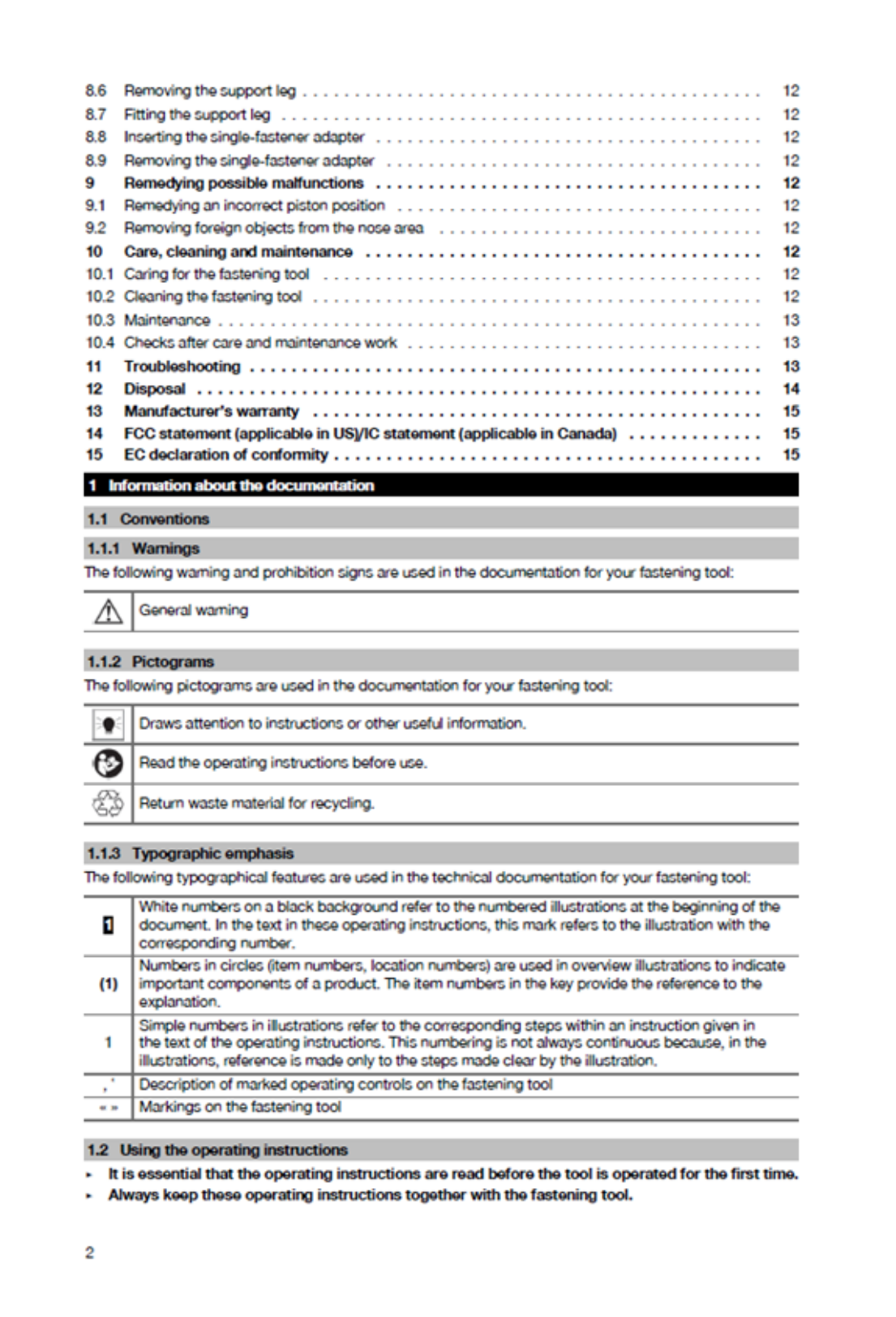

3
▶Ensure that the operating instructions are with the fastening tool when it is given to other
persons.
Changes and errors excepted.
1.3 Type designation and serial number
The type designation and serial number are printed on the type identification plate.
▶Copy these details to the table below and provide this information when making an enquiry to your Hilti
representative or to Hilti Service.
Product information
Type:
Generation: 01
Serial number:
2Safety
2.1 Intended use
The intended use of the gas-actuated fastening tool (“fastening tool”) is the driving of suitable fasteners into
concrete, steel, sand-lime block, concrete block masonry, rendered masonry and other materials suitable
for the direct fastening technique.
Further details can be found in the Fastening Technology Manual copies of which can be obtained from a
Hilti Service Center or from the following address:
Internet: http://www.hilti.com
The fastening tool is designed for professional use in drywall construction, general construction work and in
various installation trades.
The fastening tool, gas can and fasteners form a technical unit. This means that trouble-free fastening with
this fastening tool can be ensured only when it is used together with the fasteners and gas cans specially
manufactured for it by Hilti. The fastening and application recommendations made by Hilti apply only when
this condition is observed.
This fastening tool may be used only hand held or in conjunction with the special “pole tool” extension
(accessory).
The fastening tool may be operated, maintained and cared for only by suitably trained personnel. This
personnel must be informed of any particular hazards that may be encountered.
The fastening tool and its ancillary equipment may present hazards when used incorrectly by untrained
personnel or when used not as intended.
2.2 Safety instructions
Working safely with the fastening tool
▶Pressing the nosepiece of the fastening tool against a part of the body may lead to serious injury due to
inadvertent firing and release of a fastener. Never press the nosepiece of the tool against your hand
or any other part of the body. When inserting/loading an application-specific type of fastener,
never press the fastener or nosepiece of the tool against a hand or any other part of the body.
▶Never point the fastening tool towards yourself or any other person.
▶Keep your arms flexed when operating the tool (do not straighten the arms).
▶Never use a hand or any other part of the body to pull the fastener guide back when a fastener
(e.g. soft washer, clip or clamp etc.) is inserted in the nosepiece of the tool.Thispresentsan
increased risk of accident.
▶Stay alert, watch what you are doing and use common sense when operating the fastening tool.
Do not use the fastening tool while you are tired or under the influence of drugs, alcohol or
medication. A moment of inattention while operating the fastening tool may result in serious personal
injury.
▶When pulling back the nail pusher, always take care to ensure that it engages.
▶When disengaging the nail pusher, do not release it and allow it to jump forward. Guide it forward
slowly. There is a risk of pinching the fingers.
▶Do not attempt to drive fasteners into materials that are too hard, such as welded steel or cast steel.
Attempting to drive fasteners into these materials may lead to malfunctions, incorrectly driven fasteners
or breakage of fasteners.
4
▶Do not attempt to drive fasteners into materials that are too soft,suchaswoodordrywall/gypsum
board. Attempting to drive fasteners into these materials may lead to malfunctions and fasteners being
driven incorrectly or driven right through the material.
▶Do not attempt to drive fasteners into materials that are too brittle, such as glass or tiles. Attempting
to drive fasteners into these materials may lead to malfunctions, fasteners being driven incorrectly and
may cause the material to shatter.
▶Before driving fasteners, check that there is no risk of injuring persons or of damaging objects present
behind or below the working surface.
▶Pull the trigger only when the fastening tool is pressed against the working surface in such a way that
the fastener guide is pushed into the nose of the tool as far as it will go.
▶Always wear gloves if you have to carry out maintenance work on the fasteningtoolwhileitis
still hot.
▶If fasteners are driven at a high rate or if the tool used for a long period, surfaces of the tool beyond the
grip areas may get hot. Wear protective gloves to avoid burning injuries.
▶If the fastening tool overheats, remove the gas can and allow the tool to cool down. Do not exceed the
specified maximum fastener driving rate.
▶Driving fasteners may cause flying fragments or result in parts of the nail strip material being forcibly
ejected from the tool. Flying fragments present a risk of injury to the body and eyes. Wear eye
protection and a hard hat. Other persons in the vicinity must also wear eye protection and a hard hat.
▶Wear your personal protective equipment and always wear protective glasses. Depending on the
application and type of tool in use, wearing personal protective equipment such as a dust mask,
non-slip safety footwear, hard hat and ear protection reduces the risk of injury.
▶Wear suitable ear protection. Fasteners are driven through ignition of a gas/air mixture. The resulting
noise exposure may cause damage to the hearing. Other persons in the vicinity should also wear
suitable hearing protection.
▶Observe the application guidelines concerning minimum fastener spacing distances and distances from
edges of the material ( → page 7).
▶When driving a fastener, always hold the fastening tool securely and at right angles to the supporting
material. This helps to avoid deflection of the fastener by the supporting material.
▶Never drive a second fastener at the same location. This may lead to breakage or jamming of fasteners.
▶Alway remove the gas can and ( → page 10) empty the magazine ( → page 11) before changing the
magazine, before cleaning, servicing or maintenance work on the tool, before storage or transport and
before leaving the fastening tool unattended.
▶To ensure that the fastening tool functions faultlessly and as intended, always check the tool and
accessories for possible damage before use. Check that moving parts function faultlessly, without
sticking, and that no parts are damaged. In order to ensure faultless operation of the tool, all parts must
be fitted correctly and must meet the necessary requirements. Damaged protective devices or other
parts must be properly repaired or replaced by Hilti Service unless otherwise stated in the operating
instructions.
▶Have the fastening tool repaired only by trained and qualified specialists using genuine Hilti spare parts.
This will ensure that the safety of the fastening tool is maintained.
▶Tampering with or modification of the fastening tool is not permissible.
▶Do not use the fastening tool where there is a risk of fire or explosion.
▶Take influences of the surrounding area into account. Do not expose the fasteningtooltorainorsnow
and do not use it in damp or wet conditions.
▶Use the fastening tool only in well-ventilated working areas.
▶Select the correct combination of fastener guide and fastener. The wrong combination may result in
damage to the tool and in reduced fastening quality.
▶Always observe the application guidelines → page 7.
Hazards presented by electricity
▶Before beginning work, check the working area (e.g. using a metal detector) to ensure that no
concealed electric cables or gas and water pipes are present.
▶Hold the fastening tool only by the insulated grip when working in areas where fasteners may be driven
inadvertently into concealed electric cables. Contact with a live electric cable may cause metal parts of
the tool also to become live, leading to a risk of electric shock.
Instructions for handling the propellant gas
▶Observe the instructions printed on the gas can and in the accompanying information.
▶Escaping gas is harmful to the lungs, skin and eyes. Keep your face and eyes away from the gas can
compartment for up to about 10 seconds after removing the gas can.

5
▶Do not operate the gas can valve manually.
▶If a person has inhaled gas, take the person into the open air and place the person in a comfortable
position.
▶Should a person becomes unconscious, bring the person into a well-ventilatedareaandplacethe
person in a stable recovery position (i.e. lying on the side). If the person is not breathing, administer
artificial respiration and, if necessary, supply oxygen.
▶After eye contact with gas, rinse the open eyes thoroughly under running water for several minutes.
▶After skin contact with gas, wash the contact area carefully with soap and warm water. Subsequently
apply a skin cream.
▶Consult a doctor if necessary.
General instructions concerning personal safety
▶Take care to adopt an ergonomic body position. Work from a safe stance and take care to stay
in balance at all times. This will allow you to control the fastening tool better,eveninunexpected
situations.
▶Keep other people away from the working area, especially children.
3 Description
3.1 Items supplied
1 gas-actuated fastening tool with fastener guide, 1 toolbox, 1 operating instructions
Accessories and consumables
Approved accessories and consumables (gas cans and fasteners) can be found here:
Internet: http://www.hilti.com
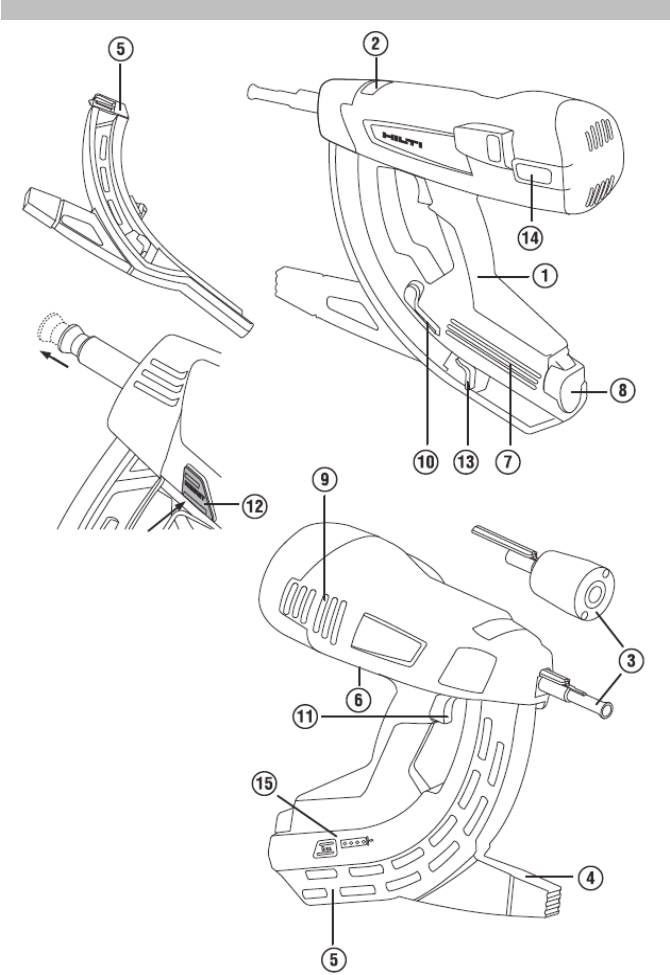
6
3.2 Parts and operating controls
@Grip
;Slider for fastener driving depth adjustment
and for releasing the fastener guide
=Fastener guide
%Support leg
&Magazine
(Type identification plate
)Gas can compartment

7
+Gas can compartment cover
§Cooling air slots
/Magazine lockbutton
:Trigger
·‚RESET‘ button
$Nail pusher
£Belt hook
|Gas can status indicator
¡Inlet/outlet valve
3.3 Fastener guide
The fastener guide holds the studs or, respectively, guides the nails and, when the tool is fired, thus directs the
fasteners into the supporting material at the desired position. Application-specific fastener guides (IF or ME)
are available for the ‚GX 3‘ and ‚GX 3-ME‘ fastening tools (see type identification plate for exact designation).
3.4 Fasteners
Two types of fastener can be driven by the fastening tool: nails and threaded studs. Additional fastening
components, which can be inserted in the fastener guide, are also available for various applications.
3.5 Guidelines for use on concrete and steel
Information about national regulations, and the Fastening Technology Manual containing further informa-
tion, are available from the Hilti marketing organization responsible for your location.
The Fastening Technology Manual can also be obtained from:
Internet: http://www.hilti.com
3.6 Slider for fastener driving depth adjustment and for releasing the fastener guide
The slider can be used to reduce the depth to which the fastener is driven. In the «EJECT» position, it
releases the fastener guide for removal.
Status Meaning
«+» • Standard fastener driving depth
«» • Reduced fastener driving depth
«EJECT» •Fastenerguiderelease
3.7 ‚RESET‘ button
After driving a fastener, under certain circumstances, the fastener guide may not return to its outset position.
This is caused by the piston being incorrectly positioned. The incorrect piston position can be remedied by
pressing the ‚RESET‘ button.
Status Meaning
‚RESET‘ button projects from the tool casing. Its
white edge is visible.
• Piston position is incorrect
‚RESET‘ button is flush with the tool casing. • Piston position is correct
3.8 Support leg
On an even working surface, the support leg makes it easier to hold the fastening tool perpendicular as
attention then only has to be paid to lateral alignment. On an uneven or undulating surface it may be necessary
to remove the support leg in order to allow the fastener guide to be held perpendicular to the working surface.
3.9 Belt hook
The belt hook can be extended in two stages.
Status Meaning
First position • Position for attaching to a waist belt
Second position • Position for attaching to ladders, scaffolds,
platforms, etc.

8
3.10 Gas can
Note
Observe the safety instructions provided with the gas can!
In order to operate the fastening tool, the gas can must be inserted in the gas can compartment.
The gas can status can be read from the LED display after pressing the ‚GAS‘ button.
The gas can must be removed before breaks between working, before maintenance and before transporting
or storing the fastening tool.
3.11 Indication of gas can status
After pressing the ‚GAS‘ button, the LED display indicates the status of the gas can.
Status Meaning
All four LEDs light green. • Level is approx. 100 %.
Three LEDs light green. • Level is approx. 75 %.
Two LEDs light green. • Level is approx. 50 %.
One LED lights green. • Level is approx. 25 %.
One LED blinks green. • Level is below 10 %. Replacement of the gas
can is recommended.
One LED lights red. • There is either no gas can in the fastening tool,
the wrong type of gas can is fitted or the can is
empty.
Note
Even when the level is indicated as “empty”, the gas
can, for technical reasons, still contains a little gas.
4 Technical data
4.1 Fastening tool
Weight (empty) 3.9 kg
(8.60 lb)
Application temperature, ambient temperature −10℃…45℃
(14.0 ℉ …113.0 ℉)
Maximum fastener length ≤39mm
(≤ 1.54 in)
Fastener diameter • 2.6 mm (0.102 in)
•3mm(0.12in)
Compression stroke 40 mm
(1.57 in)
Magazine capacity in strips of 10 nails (Magazine capac-
ity)
1…4
Maximum fastener driving frequency (Fasteners per hour) 1,200
4.2 Noise information in accordance with EN 60745
Sound (power) level (LWA)0dB(A)
Uncertainty for the sound power level (KWA)0dB(A)
Emission sound pressure level (LpA)0dB(A)
Uncertainty for the sound pressure level (KpA)0dB(A)
4.3 Total uniaxial vibration value (in z-direction)
The vibration emission level stated in these instructions has been measured in accordance with a standardized
test given in EN 792-13/ISO 11148-13 and may be used to compare one direct fastening tool with another.
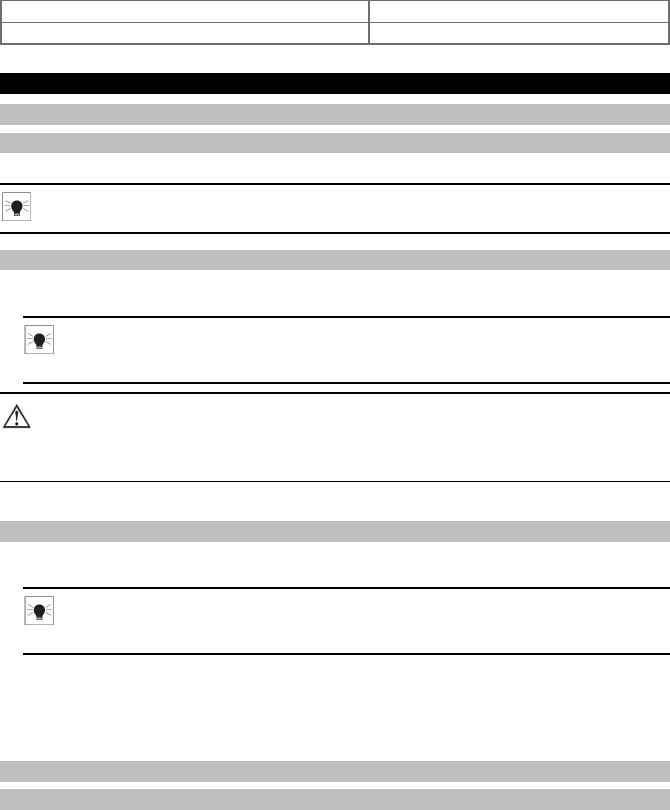
9
It may be used for a preliminary assessment of exposure. The declared vibration level represents the main
applications of the direct fastening tool. However, if the direct fastening tool is used for different applications,
with different items of equipment or accessories or is poorly maintained, the vibration level may vary. This
may significantly increase the exposure to vibration over the total working period. An accurate estimation of
exposure to vibration should also take into account the times when the tool is not actually in use. This may
significantly reduce the exposure to vibration over the total working period.
Identify additional safety measures to protect the operator from the effects of vibration such as: maintenance
of the direct fastening tool and its additional equipment or accessories, keeping the hands warm, organization
of work patterns.
Driving fasteners (ah)0m/s²
Uncertainty for the given vibration value (K) 0m/s²
5 Loading the fastening tool
5.1 Loading for driving nails
5.1.1 Equipment required for driving nails
Nails are fed through the magazine in strip form (ready-to-use strips of nails).
Note
When driving nails there must be no single-fastener adapter present in the tool .
5.1.2 Loading the magazine
1. Pull the nail pusher back until it engages.
2. Slide the nail strips into the magazine as far as they will go.
Note
Strips of short nails could be inadvertently inserted the wrong way round. With short nails, take
care to ensure that the tips of the nails point towards the nose of the tool.
WARNING
Risk of pinching fingers! Fingers could be pinched when the nail pusher is released.
▶When disengaging the nail pusher, do not release it and allow it to jump forward. Guide it forward
slowly as far as it will go.
3. Release the nail pusher and guide it forward as far as it will go.
5.1.3 Inserting the gas can
1. Open the gas can compartment cover.
2. Removethecapfromthegascan.
Note
Keep the cap so that it can be used to close the gas can securely when it is removed from the
tool,e.g.whenunloadingandfortransport.
3. Slide the gas can into the gas can compartment, valve first, so that the gas can clip enters the opening
for the clip and engages securely.
4. Close the gas can compartment cover.
5. Without pulling the trigger, firmly press the nose of the fastening tool twice against the working surface
in order to force the air out of the gas supply tubes.
5.2 Loading for driving threaded studs
5.2.1 Equipment required for driving threaded studs
Threaded studs must be inserted singly in the fastener guide from the front. An adapter is required for driving
single fasteners. Each package of threaded studs contains an adapter for driving single fasteners.
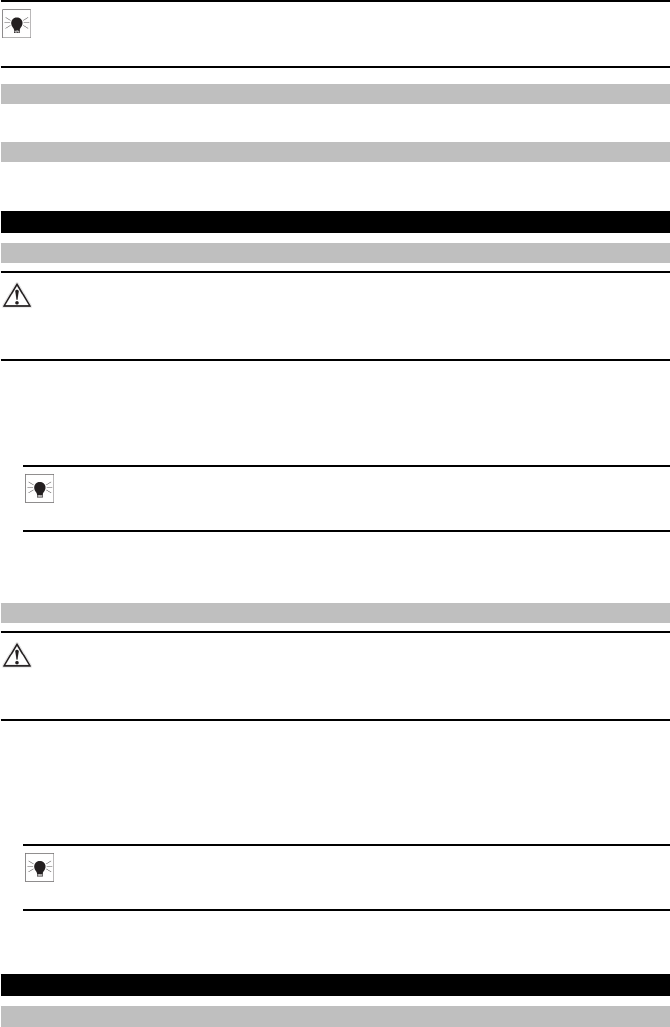
10
Note
In order to drive threaded studs, the magazine must first be emptied and an adapter for driving single
fasteners inserted.
5.2.2 Inserting the single-fastener adapter
▶Insert the single-fastener adapter ( → page 12).
5.2.3 Inserting the gas can
▶Insert the gas can ( → page 9).
6 Driving fasteners
6.1 Driving nails
WARNING
Risk of injury! Pressing the nosepiece of the fastening tool against a part of the body may lead to
serious injury due to inadvertent firing and release of a fastener.
▶Never press the nosepiece of the tool against your hand or any other part of the body.
1. Check the fastener driving depth setting.
2. Bring the nosepiece of the fastening tool and the support leg into contact with the working surface.
3. Press the nose of the fastening tool against the working surface as far as it will go (fully compressed).
4. Check that the nose of the tool is perpendicular to the working surface.
5. Pull the trigger to drive a fastener.
Note
It is not possible to drive a fastener if the nose of the tool is not pressed fully against the working
surface.
6. Lift the fastening tool completely away from the working surface after driving a fastener.
7. Remove the gas can ( → page 10) and empty the magazine ( → page 11) when work with the fastening
tool is finished or before leaving the tool unattended.
6.2 Driving threaded studs
WARNING
Risk of injury! High risk of injury caused by inadvertently driving a fastener into a part ofthebody.
▶When inserting fasteners, never press the fastener guide against a hand or other part of the
body.
1. Check the fastener driving depth setting.
2. Insert a stud in the fastener guide.
3. Bring the nosepiece of the fastening tool and the support leg into contact with the working surface.
4. Press the nose of the fastening tool against the working surface as far as it will go (fully compressed).
5. Check that the nose of the tool is perpendicular to the working surface.
6. Pull the trigger to drive a fastener.
Note
It is not possible to drive a fastener if the nose of the tool is not pressed fully against the working
surface.
7. Remove the gas can when work with the fastening tool is finished or before leaving the tool unattended
(→page10).
7 Unloading the fastening tool
7.1 Removing the gas can
1. Open the gas can compartment cover.

11
2. Press the gas can clip to release the gas can.
3. Remove the gas can from the gas can compartment.
4. Fit the cap on the gas can.
5. Close the gas can compartment cover.
7.2 Unloading the magazine
1. Pull the nail pusher back until it engages.
2. Remove all nail strips from the magazine.
WARNING
Risk of pinching fingers! Fingers could be pinched when the nail pusher is released.
▶When disengaging the nail pusher, do not release it and allow it to jump forward. Guide it forward
slowly as far as it will go.
3. Release the nail pusher and guide it forward as far as it will go.
7.3 Removing the single-fastener adapter
▶After driving the fasteners, remove the single-fastener adapter ( → page 12) from the fastening tool.
8 Optional operating steps
8.1 Checking the status of the gas can
1. Without pressing the fastening tool against the working surface, press the ‚GAS‘ button.
2. Read the gas can status from the display. → page 8
8.2 Removing the magazine
1. Pull the nail pusher back until it engages.
2. Remove the loose nail strips from the magazine.
WARNING
Risk of pinching fingers! Fingers could be pinched when the nail pusher is released.
▶When disengaging the nail pusher, do not release it and allow it to jump forward. Guide it forward
slowly as far as it will go.
3. Release the nail pusher and guide it forward as far as it will go.
4. Release the magazine locking catch.
5. Pivot the magazine about the pivot point towards the front.
6. Detach the magazine.
8.3 Fitting the magazine
1. Engage the front end of the magazine at the nose of the fastening tool.
2. Pivot the magazine towards the fastening tool.
3. Close the magazine locking catch.
8.4 Removing the fastener guide
1. Remove the gas can. → page 10
2. Move the fastener guide release slider to the «EJECT» position.
3. Remove the fastener guide.
8.5 Inserting the fastener guide
1. Remove the gas can. → page 10
2. Slide the fastener guide into the slot in the nose of the fastening tool.
3. Hold the fastener guide securely so that it cannot fall out and then press thenoseofthetool(i.e.the
tool with the fastener guide) against a firm surface until the fastener guide engages.
4. Check that the fastener guide has engaged.
◁Once the fastener guide has engaged, the slider for releasing the fastener guide is again in the «+»
position.

12
8.6 Removing the support leg
1. Release the support leg engaging mechanism by pressing lightly.
2. Rotate the support leg through 90°.
3. Remove the support leg.
8.7 Fitting the support leg
1. Bring the support leg into contact with the magazine at right angles and guide it into the slot.
2. Rotate the support leg through 90° relative to the magazine and allow it to engage while applying light
pressure.
8.8 Inserting the single-fastener adapter
1. Remove the gas can. → page 10
2. Remove the magazine. → page 11
3. Insert the single-fastener adapter.
4. Fit the magazine. → page 11
8.9 Removing the single-fastener adapter
1. Remove the gas can. → page 10
2. Remove the magazine. → page 11
3. Remove the single-fastener adapter.
4. Fit the magazine. → page 11
9 Remedying possible malfunctions
9.1 Remedying an incorrect piston position
▶Check the position of the ‚RESET‘ →page7button.
Result
•‚RESET‘ button projects from the tool casing. Its white edge is visible.
To remedy the incorrect piston position, press the ‚RESET‘ button.
9.2 Removing foreign objects from the nose area
1. Remove the magazine. → page 11
2. Remove the fastener guide. → page 11
3. Remove all foreign objects from the nose area.
4. Insert the fastener guide. → page 11
5. Fit the magazine. → page 11
10 Care, cleaning and maintenance
10.1 Caring for the fastening tool
▶Never operate the fastening tool if the cooling air slots are blocked.
▶Keep the grip areas free from oil and grease.
▶Clean the fastening tool regularly. → page 12
▶Do not use spray devices, pressure jet washers or running water for cleaning.
▶Do not use cleaning agents containing silicone.
▶Do not use sprays or similar lubricating and cleaning agents.
10.2 Cleaning the fastening tool
1. Remove the gas can. → page 10
2. Unload the magazine. → page 11
3. Remove plastic fragments from the fastener guide.
4. Use a dry brush to clean the cooling air slots, taking care to prevent dirt or foreign objects entering the
interior of the tool.
5. Use a damp cloth to clean the exterior of the tool.
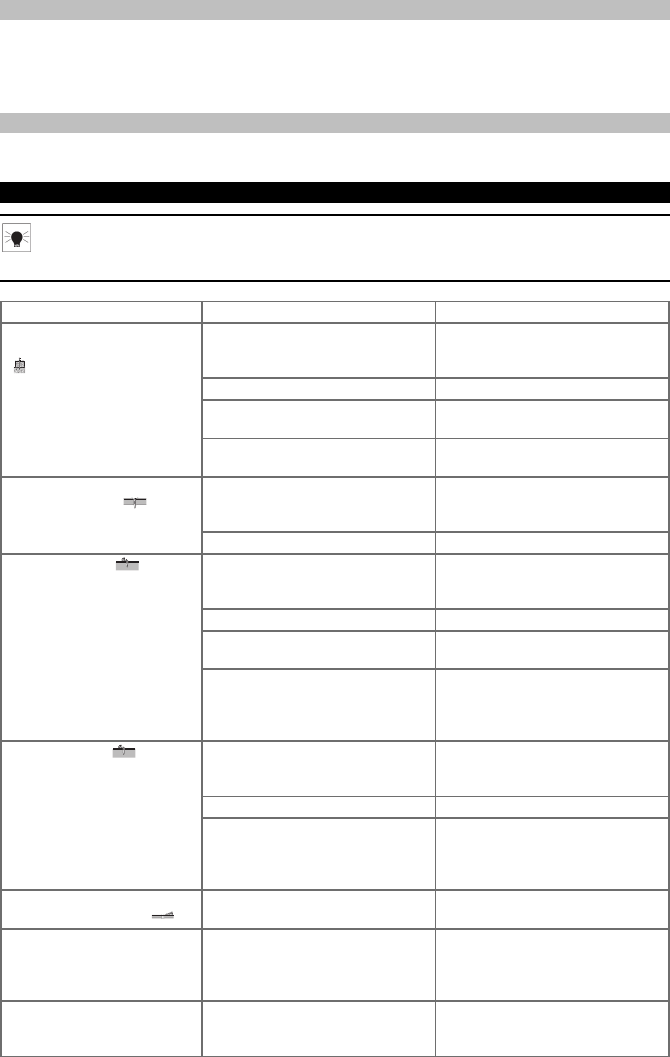
13
10.3 Maintenance
▶Check all external parts of the fastening tool regularly for damage and make sure that all operating
controls function faultlessly.
▶Do not use the fastening tool if parts are damaged or if operating controls do not function faultlessly.
▶Have a defective fastening tool repaired by Hilti Service.
10.4 Checks after care and maintenance work
▶Move the fastener driving depth adjustment slider to the «+» position.
11 Troubleshooting
Note
If the fault you are experiencing is not listed or the recommended action to be taken does not
successfully solve the problem, please contact Hilti Service.
Fault Possible cause Action to be taken
Fasteners are frequently
driven to inadequate depth.
Driving power is too low. ▶Move the fastener driving depth
adjustment slider to the «+»
position.
The fasteners are too long. ▶Use shorter fasteners.
The supporting material is too
hard.
▶Consider using a DX fastening
tool.
The inlet/outlet valve is clogged or
covered over.
▶Clean the fastening tool and
check how it is held.
Fasteners are frequently
driven too deeply.
Driving power is too high. ▶Move the fastener driving depth
adjustment slider to the «‒»
position.
The fasteners are too short. ▶Use longer fasteners.
Fasteners break. Driving power is too low. ▶Move the fastener driving depth
adjustment slider to the «+»
position.
The fasteners are too long. ▶Use shorter fasteners.
The supporting material is too
hard.
▶Consider using a DX fastening
tool.
The fastener guide is not held per-
pendicular to the working surface.
▶Press the nosepiece against
the working surface while keep-
ing the tool perpendicular to
the surface.
Fasteners bend. Driving power is too low. ▶Move the fastener driving depth
adjustment slider to the «+»
position.
The fasteners are too long. ▶Use shorter fasteners.
The fastener guide is not held per-
pendicular to the working surface.
▶Press the nosepiece against
the working surface while keep-
ing the tool perpendicular to
the surface.
The fastener doesn’t hold
when driven into steel.
The supporting material is too thin. ▶Use a different fastening
method.
The content of the gas can is
inadequate for the number of
fasteners in the package.
High gas consumption due to fre-
quent compression of the tool
nosepiece without driving a fas-
tener.
▶Avoid compressing the tool
nosepiece without driving a
fastener.
The tool remains compressed
(nose does not extend when
pressure is released).
Incorrect piston position. ▶Remedy the incorrect piston
position. → page 12

14
Fault Possible cause Action to be taken
The tool remains compressed
(nose does not extend when
pressure is released).
The nail detector is jammed and
the ‚RESET‘ button is not flush
with the casing when pressed.
▶Remove foreign objects from
thenosearea.→page12
A fastener has jammed in the fas-
tener guide.
▶Release the jammed fastener.
Fastener driving failure rate is
too high.
The fastener guide is not held per-
pendicular to the working surface.
▶Press the nosepiece against
the working surface while keep-
ing the tool perpendicular to
the surface.
Wrong type of fastener used. ▶Use a suitable type of fastener.
The supporting material is too
hard.
▶Consider using a DX fastening
tool.
No fastener is driven. The nail pusher was not moved
forwards.
▶Release the nail pusher and
guide it forward as far as it will
go.
Inadequate number of nails in the
magazine.
▶Load the magazine. → page 9
Nail transport malfunction. ▶Use a different nail strip.
▶Clean the magazine.
Gas can is empty. ▶Check the status of the gas
can. → page 11
One LED lights red. ▶Check the status of the gas
can. → page 11
Air in the gas lines. ▶Press the nosepiece against
the working surface twice with-
out pulling the trigger.
Foreignobjectinthenosearea. ▶Remove foreign objects from
thenosearea.→page12
The fastening tool is too hot. ▶Allow the fastening tool to cool
down.
Electronic fault. ▶Remove the gas can and then
reinsert it. If the problem per-
sists, use a new gas can.
The fastening tool is hot and
doesn’t work even after a
break.
The fastener driving rate was well
above 1,200 fastenings per hour.
▶Allow the fastening tool to cool
down.
No fastener is driven (or
driven only intermittently).
Ambient conditions are outside the
permissible range.
▶Make sure that the permissible
ranges, in accordance with the
technical data, are observed.
The gas can temperature is outside
the permissible range.
▶Make sure that the permissible
ranges, in accordance with the
technical data, are observed.
Gas bubbles have formed in the
gas regulating system.
▶Remove the gas can and then
reinsert it.
The tool was not lifted completely
away from the surface after driving
afastener.
▶Lift the fastening tool com-
pletely away from the working
surface after driving a fastener.
A fastener cannot be
removed from the fastener
guide.
A fastener has jammed in the fas-
tener guide.
▶Release the jammed fastener.
12 Disposal
Most of the materials from which Hilti tools, appliances and devices are manufactured can be recycled.
The materials must be correctly separated before they can be recycled. In many countries, Hilti has already
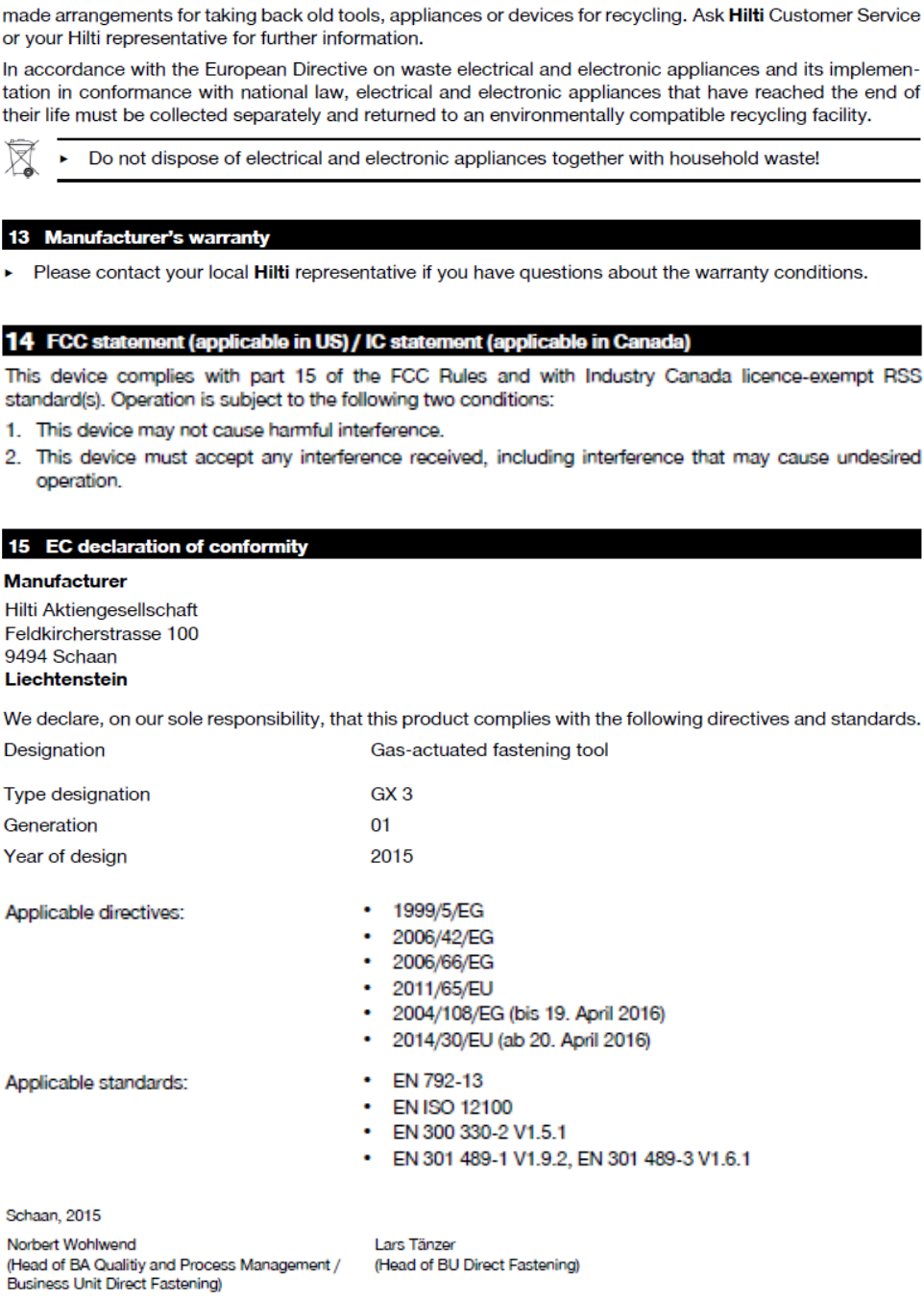
15

Hilti = registered trademark of Hilti Corp., Schaan
20150129
**